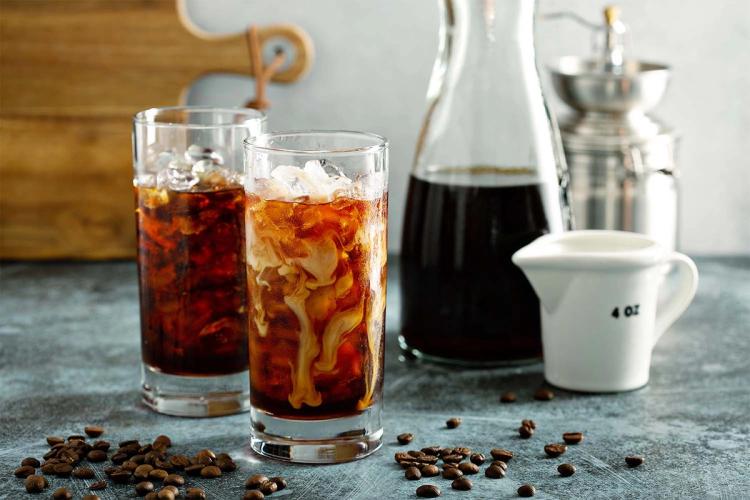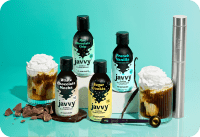
Cold Brew vs. Iced Coffee: Which To Go For?
Some people enjoy black coffee. Some prefer coffee with cream and sugar. Some enjoy regular drip coffee, while others opt for lattes.
The list of ways to enjoy coffee is always expanding. Not to mention the classic question: "Do you want your coffee hot or cold?"—which is actually a question of "hot, cold, or iced." So, what is the difference between cold brew coffee and iced coffee?
For some, cold brew and iced coffee might sound like the same thing. However, their flavors, brewing methods, and prices differ for several reasons.
Read on to discover what makes each of these drinks unique.
What Is Iced Coffee?
The history of iced coffee is somewhat unclear. Since it is simply hot coffee poured over ice, pinpointing its exact origin is difficult.
However, there is evidence that iced coffee was being made in the 17th century in Vienna when the Turks passed through. In Western culture, iced coffee did not gain widespread popularity until the early 2000s. Between 2009 and 2013, the iced coffee industry boomed, and its popularity has continued to grow ever since.
How Is Iced Coffee Made?
Iced coffee is made by brewing hot coffee, allowing it to cool to room temperature, and then pouring it over ice.
The downside of this method is that the coffee often tastes burnt, acidic, or watery. The rich, natural flavor notes are not as pronounced as they are when the coffee is consumed hot. The best way to make iced coffee quickly while preserving its flavor quality is through the flash brew method.
To flash brew, use double the amount of coffee grounds typically used for a regular pot of coffee. Fill a pitcher halfway with ice. Once the coffee finishes brewing, pour it directly over the ice-filled pitcher. This method ensures your coffee is chilled and ready to be enjoyed as iced coffee.
Ratios and Roasts for Flash-Brewed Iced Coffee
The most common ratio for the flash brew method is 1:10—meaning 1 gram of coffee per 10 grams of water. In comparison, the typical ratio for a regular pot of coffee or a pour-over is 1:17.
Flash brew is meant to be stronger, which is why it uses less water per gram of coffee. The coffee should be ground to a medium-fine level. The choice of roast depends on personal flavor preferences.
Most flash brews work best with a medium to dark roast, though a light roast can be used for those who prefer fruitier flavors.
Cold Brew
Which came first, iced coffee or cold brew? Ironically, both are credited with originating in the 17th century. However, iced coffee was created in Europe, while cold brew was developed in Japan.
Cold brew was first made using the Kyoto method, which involves ice water, coffee grounds, and a glass spiral resembling a chemistry experiment. Water travels through the spiral and drips slowly over the coffee grounds at about one drop per second.
Cold brew takes over 24 hours to make, and due to this long extraction period, it is extremely strong and condensed.
How To Make Cold Brew
Cold brew never touches heat and typically takes about 16–20 hours to prepare, whereas flash-brewed iced coffee is made quickly by pouring hot coffee over ice. Cold brew is more time-consuming but is less acidic due to its slow extraction process.
Cold brew is made similarly to iced tea: coarsely ground coffee is placed in a filter and steeped in cold water for up to 20 hours. Steeping longer than 20 hours can lead to over-extraction, resulting in a sour taste.
After steeping for 20 hours, remove the filter, pour over ice, and enjoy your cold brew!
Ratios and Roasts for Cold Brew
For cold brew, the ratio is 1:4—using even more coffee than flash brew. Combined with the 16–20-hour steeping process, this results in an exceptionally strong drink.
Cold brew enhances coffee's naturally sweet flavor notes and is typically made with a medium-dark roast. Roasts with chocolatey, caramel, or nutty flavors work best, as the long extraction process highlights these notes.
When making cold brew, use a coarse grind to ensure the water breaks down the grounds efficiently during the extended steeping period.
Which Is Better: Cold Brew or Iced Coffee?
Both flash-brewed iced coffee and cold brew are great cold coffee options, each offering unique flavors and qualities.
However, are there differences beyond their brewing methods? Now that we've broken down the basics, let's explore which one might offer more health benefits.
Iced Coffee vs. Cold Brew: Health Benefits
Coffee is rich in antioxidants and provides long-term health benefits. It has been linked to a lower risk of type 2 diabetes and may even reduce the risk of certain cancers.
Both hot and flash-brewed iced coffee retain these benefits. However, because they go through a heated brewing process, some antioxidants are lost.
Cold brew, on the other hand, does not use heat, making it less acidic. However, the prolonged steeping time results in a greater loss of antioxidants compared to flash-brewed coffee.
Pros and Cons
Each cold coffee method has its advantages. One may be more antioxidant-rich, while the other is gentler on the stomach due to lower acidity.
However, the way you drink your coffee—whether with cream, sugar, or flavored syrups—can impact its overall health benefits. Small additions add up quickly, so moderation is key.
Cold brew is known for having higher caffeine content, as it typically contains more coffee per ounce. If you need an extra energy boost, cold brew might be the better choice. Either way, both iced coffee and cold brew are great ways to start your day or enjoy an afternoon pick-me-up!
Coffee Costs
The price difference between iced coffee and cold brew comes down to the amount of coffee used and the labor involved in making cold brew. Cold brew is more expensive because it requires more coffee per ounce and takes longer to prepare.
Flash-brewed iced coffee uses more coffee than regular drip coffee but requires less time and effort, making it more affordable. If you're on a budget, swapping cold brew for iced coffee can help you save money without giving up your coffee fix.
Cold Brew vs. Iced Coffee: The Finale
There are pros and cons to both cold brew and iced coffee. The choice ultimately depends on individual taste preferences.
Depending on the weather, your mood, or your personal taste, one option may be more appealing than the other. However, at the end of the day, both drinks offer health benefits, taste delicious, and are great for sharing with friends over a cup of coffee.







